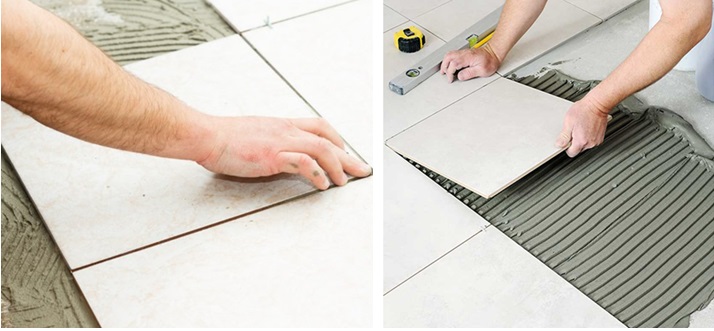Discover the Keys to Perfect Floor Tile Setup Whenever
Grasping the art of floor tile installation involves a series of exact actions and strategies that, when implemented correctly, can result in a seamless and sleek finish. By understanding the secrets behind each step, you can guarantee that your tile setup not just satisfies but exceeds your assumptions.
Proper Surface Prep Work
Effective floor tile setup pivots considerably on meticulous surface preparation to make certain a flawless end result. The surface should be tidy, dry, and structurally sound to prevent future issues such as loose tiles or broken grout.
To assure proper attachment, it is advised to rough up smooth surface areas via sanding or scarifying. Furthermore, using a guide can boost bonding in between the ceramic tile and the substrate adhesive. Irregular surfaces should be leveled using a self-leveling compound to avoid lippage and make certain a smooth surface.
Furthermore, inspecting for prospective resources of moisture is critical, as excess wetness can lead to mold development and damage the floor tiles with time. Utilizing a dampness obstacle or waterproofing membrane in wet areas like bathrooms or kitchen areas is vital to safeguard the ceramic tiles from water damages. By thoroughly preparing the surface prior to tile installation, one can develop a visually attractive and resilient tiled location that will stand the examination of time.

Choosing the Right Adhesive
Choosing the proper adhesive is a crucial action in making certain the effective installment of floor tiles. The sort of sticky you select will depend upon different variables such as the kind of ceramic tile, the substrate product, and the location of the installment. There are various kinds of adhesives offered in the marketplace, consisting of thin-set mortar, mastic, and epoxy.

Epoxy adhesives are exceptionally sturdy and waterproof, making them excellent for locations vulnerable to moisture such as restrooms or cooking areas. They are additionally appropriate for mounting glass or steel ceramic tiles. When picking an adhesive, make certain to follow the manufacturer's recommendations and think about the particular needs of your tile installation task.
Accuracy Reducing Strategies
One of the most common tools made use of for precision cutting in ceramic tile setup is the ceramic tile cutter. Tile cutters come in numerous types, consisting of manual ceramic tile cutters, electric wet saws, and handheld ceramic tile cutters. Hands-on floor tile cutters are suitable for straight cuts on ceramic and porcelain tiles, providing tidy and precise edges.
Additionally, making use of tools like floor tile scribes or glass cutters can aid in racking up and snapping ceramic tiles with precision. By mastering these accuracy reducing techniques, tile installers can guarantee a specialist surface and an aesthetically appealing result in their ceramic tile jobs.

Grout Application Tips
When transitioning from precision reducing methods to grout application in tile setup, focus to information and technique is vital for achieving a flawless coating. Cement serves not just as a functional component that loads the spaces in between tiles but visit this page also plays a considerable function in the general visual of the installment. To make sure a successful grout application, begin by picking the suitable kind and color of cement that matches the floor tiles. Mix the grout according to the producer's directions, making certain a lump-free and smooth consistency.
When using grout, operate in tiny sections at a time to avoid it from drying out as well rapidly. Use a rubber float to push the grout into the joints at a 45-degree angle, making sure full insurance coverage and compacting the material. As soon as the cement is used, utilize a damp sponge to clean look at this now up the tiles, ensuring not to get rid of cement from the joints. Buff the tiles with a dry cloth to eliminate any type of haze and accomplish a refined coating. Complying with these grout application pointers will cause a skillfully set up tile surface that boosts the elegance of any space.
Finishing Touches and Maintenance
To finish the floor tile installment job efficiently, focus to detail during the finishing touches and regular maintenance is essential. After the grout has dried out and the ceramic tiles are securely in place, the final actions entail making sure that all sides are appropriately secured.
Normal upkeep is key to protecting the elegance and capability of your tiled surfaces. A simple routine of sweeping or vacuuming followed by mopping with a mild cleanser can help keep your ceramic tiles looking pristine (tile installation austin). For areas that are frequently revealed to wetness, such as kitchen areas or washrooms, regular resealing of cement lines is suggested to avoid mold and mildew and mold growth
Conclusion
To conclude, accomplishing ideal ceramic tile visit this page setup every single time calls for focus to information and appropriate strategies. By concentrating on surface prep work, picking the right adhesive, utilizing accuracy cutting approaches, using cement meticulously, and do with attention to information, you can ensure a professional-looking result. Remember to comply with these steps and keep your floor tiles regularly to extend their life expectancy and keep them looking their ideal.
One of the most common tools utilized for accuracy cutting in tile installation is the tile cutter. Floor tile cutters come in various types, consisting of hands-on floor tile cutters, electrical damp saws, and portable ceramic tile cutters. Hand-operated ceramic tile cutters are suitable for straight cuts on ceramic and porcelain tiles, supplying tidy and exact sides. Additionally, making use of tools like floor tile scribes or glass cutters can aid in racking up and breaking ceramic tiles with precision. By understanding these accuracy reducing methods, ceramic tile installers can ensure an expert coating and a visually enticing outcome in their tile jobs.
 Elin Nordegren Then & Now!
Elin Nordegren Then & Now! Matilda Ledger Then & Now!
Matilda Ledger Then & Now! Elisabeth Shue Then & Now!
Elisabeth Shue Then & Now! Monica Lewinsky Then & Now!
Monica Lewinsky Then & Now! Lynda Carter Then & Now!
Lynda Carter Then & Now!